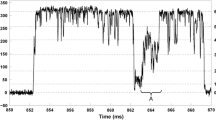Abstract
Ion channel current amplitudes (μ) and open probabilities (P o) have been analysed so far by defining a 50% threshold to distinguish between open and closed states of the channels. With this standard method (SM) it is very difficult or even impossible to analyse channels of different size in one membrane patch correctly. A stochastical model, named the hidden Markov model (HMM), separates between observation noise and the stochastic process of opening and closing of ion channels. The HMM allows the independent analysis of μ, P o, and mean dwell times (τ) of different channels in one membrane patch, without defining threshold levels. Using this method errors in the analysis are not summarized like in the SM because all different analysing procedures (e. g. filtering, setting of threshold, fitting processes) are done in one step. Two different K+ channels in excised basolateral membranes of the cortical collecting duct of rat (CCD) were analysed by the SM and the HMM. The μ value of the intermediate-conductance K+ channel (i-K+) was 3.9±0.1 pA (SM) and 3.8±0.2 pA (HMM) for 11 observations. The P o value of this channel was 10.2±4.2% (SM) and 10.1±4.0% (HMM). The mean τ values were 5.4±0.6 ms for the open state and 9.6±2.2 ms and 145±21 ms for the closed states (SM) and 7.8±1.1 ms, 7.7±0.9 ms and 148±24 ms (HMM), respectively. For seven small-conductance K+ (s-K+) channels, which were found in the same membrane patches as the i-K+, an accurate analysis of P o and τ was not possible with the SM. The μ value was 1.0±0.1 (SM), 0.9±0.1 (HMM) pA. P o was 16.6±4.6%, the open τ value was 11.1±2.8 ms, and the closed τ value was 34.9±8.5 ms. The HMM allows the analysis of single-channel currents, P o, and mean τ values when different or more than one ion channel(s) are colocalized in one membrane patch. Where analysis with the SM was possible results did not significantly differ from those obtained with the HMM. Thus for this kind of analysis the method of setting a 50% threshold appears justified.
Similar content being viewed by others
References
Baum LE, Petrie T, Soules G, Weiss N (1970) A maximization technique occurring in the statistical analysis of probabilistic functions of Markov chains. Ann Math Stat 41:164–171
Becker JD (1993) Versteckte Dynamik neuronaler Prozesse — Klassifikation und Modellierung mit Hidden-Markov-Modellen. Harri Deutsch, Frankfurt (in press)
Chung SH, Moore JB, Xia L, Premkumar LS, Gage PW (1990) Characterization of single channel currents using digital signal processing techniques based on hidden Markov models. Philos Trans R Soc Lond [Biol] 329:265–285
Colquhoun D, Sigworth FJ (1983) Fitting and statistical analysis of single-channel records. In: Sakmann B, Neher E (eds) Single-channel recording. Plenum Press, New York
Dempster AP, Laird NM, Rubin DR (1977) Maximum likelihood from incomplete data via the EM algorithm. J R Stat Soc [Biol] 39:1–22
Reference deleted
Efron B (1979) Bootstrap method: another look at the jack-knife. Ann Statist 7:1–26
Fredkin DR, Rice JA (1992) Maximum likelihood estimation and identification directly from single-channel recordings. Proc Trans R Soc Lond [Biol] 249:125–132
Hirsch J, Schlatter E (1993) K+ channels in the basolateral membrane of rat cortical collecting duct (CCD). Pflügers Arch (in press)
Paz A (1971) Introduction to probabilistic automata. Academic Press, New York
Rabiner LR (1989) A tutorial on hidden Markov models and selected application in speech recognition. Proc IEEE 77:257–285
Radons G, Becker JD (1993) Recognizing and simulating neuronal spike pattern with Hidden-Markov-models. In: Poeppl SJ, Handels H (eds) Mustererkennung 1993. Springer, Berlin Heidelberg New York (in press)
Viterbi AJ (1967) Error bounds for convolutional codes and an asymptotically optimum decoding algorithm. IEEE Trans Inform Theory 13:260–269
Author information
Authors and Affiliations
Rights and permissions
About this article
Cite this article
Becker, J.D., Honerkamp, J., Hirsch, J. et al. Analysing ion channels with hidden Markov models. Pflügers Arch. 426, 328–332 (1994). https://doi.org/10.1007/BF00374789
Received:
Revised:
Accepted:
Issue Date:
DOI: https://doi.org/10.1007/BF00374789




